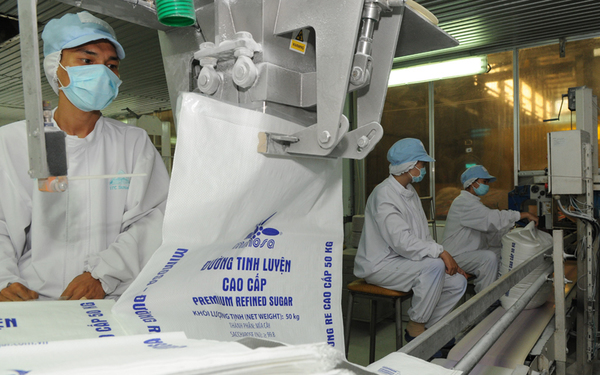Vietnam: More than 10 sugar mills shut down because of big losses
Many sugar mills have had to shut down because they cannot compete with imports.
After ATIGA (ASEAN Trade in Goods Agreement) took effect, the tariff on sugar imports to Vietnam was slashed from 85 percent to 5 percent. As a result, while domestic output was in excess, Vietnam still had a trade deficit of 884,285 tons of sugar a year.
In the 2019-2020 crop, the sugarcane growing area decreased by another 15-20 percent, which raised concern about material shortages for sugar mills.
Only 29 out of 40 sugar mills are still operational. The total sugarcane output is 5.29 million tons, or 530,000 tons of sugar.
.
Nguyen Cam Trang, deputy director of the Import-Export Department under the Ministry of Industry and Trade (MOIT), said at a workshop on the opportunities and challenges for the sugar industry on March 23 that Vietnam is one of the biggest sugar producers and consumers. It can put out 1-1.3 million tons a year, while demand for direct consumption and food processing is 2 million tons.
According to the General Department of Customs (GDC) in 2017-2019, Vietnam imported 200,000-400,000 tons of sugar. However, the tariff removal to implement ATIGA has had a big impact on domestic production and import.
The imports soared in 2020 to 1.5 million tons, which affected domestic production. Less than 900,000 tons of sugar were produced in the 2019-2020 crop, much lower than the average level of 1.2 million tons.
Le Van Tam, chair of Lam Son Sugar JSC, said that Vietnam’s sugar industry has been facing difficulties in recent years, especially after ATIGA took effect. Vietcombank Securities also pointed out that the domestic sugar industry faced a number of challenges in the long term
As Thailand subsidizes its sugar industry, Thai sugar imports have low prices with which Vietnam-made sugar mills cannot compete, including the mills which buy sugarcane at low prices from farmers.
The low sugarcane prices led to a sharp fall in sugarcane growing area, from 300,000 hectares to below 160,000, and in number of sugar mills, from 41 to 29. The mills are operating at a moderate level because the material supply just can meet 50 percent of demand.
As a result, the domestic output fell from 2 million tons to below 1 million tons a year.
MOIT gives lifebuoy
On February 9, 2021, MOIT released a decision on applying temporary anti-subsidy and anti-dumping duties on sugar imports from Thailand, 48.88 percent on refined sugar and 33.88 percent on raw sugar.
| The low sugarcane prices led to a sharp fall in sugarcane growing area, from 300,000 hectares to below 160,000, and in number of sugar mills, from 41 to 29. The mills are operating at a moderate level because the material supply just can meet 50 percent of demand. |
The move, according to Nguyen Van Loc, acting secretary of the Vietnam Sugar and Sugar Cane Association, is in line with the rules of the WTO (World Trade Organization) and Vietnamese laws.
The investigations found subsidization and dumping, causing serious damage to Vietnam’s sugar industry with 50 percent of sugarcane growing households unable to continue production and one-third of sugar mills having to shut down.
“The anti-dumping duty imposition has made a timely intervention which is like a ‘lifebuoy’ appearing when the sugar industry is ‘having a close brush with death’,” Loc said.
With an appropriate anti-dumping duty, domestic sugar prices will be equal to that in the region, helping farmers and sugar mills to develop in a fair and transparent environment.
However, as the industry has suffered heavily, it will take a lot of time to recover.
But he said that Vietnam’s enterprises can compete fairly with rivals.
The move will help to recover the material growing area. When the sugar price is higher for sugar mills, they will buy sugarcane at a higher price. If so, farmers will feel secure and try to improve yield and quality.
Some sugar mills have begun increasing the sugarcane purchasing prices in the 2020-2021 crop. Lam Son, for example, pays VND1 million per ton, or VND150,000 per ton higher than the previous crop.
In the long term, the sugar industry will not only make sugar but other products as well to optimize profits.
However, sugar producers still have worries. Tam said smuggled sugar is the biggest threat to domestic production. Smugglers may use more sophisticated tricks, thereby killing Vietnam’s industry.
Dinh Duy Vuot, a National Assembly Deputy from Gia Lai, said the sugar price surged by VND100,000-200,000 per ton, which allowed farmers to make a profit of VND30-50 million per hectare.
The sugar price has increased by nearly 50 percent, or VND4,000 per kilogram over 2020. In previous crops, farmers incurred losses, broke even or made modest profits.
However, he said in order to help the sugar industry develop in a sustainable way and compete fairly with Thailand, it is necessary to apply comprehensive measures, especially state support for farmers. It is also necessary to stop trade fraud to prevent smuggled sugar products from entering Vietnam.
Meanwhile, sugar companies need to modernize sugar mills and improve competitiveness.
Tam An
Source: https://vietnamnet.vn/en/feature/more-than-10-sugar-mills-shut-down-because-of-big-losses-724005.html


 Thailand
Thailand




